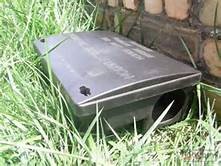Safety First with Benefits
Tamper-resistant bait stations. are lockable, durable plastic or metal boxes that contains and protects bait or traps while allowing rodents to enter. The Bait Station must meet 8 criteria that will prevent tampering and or entry by nontargets that includes children and pets. A cardboard box will not do when it comes to children and pets or if it could be reached by non-target animals indoors. It must be replaced by a tamper-resistant bait station. Don’t assume that the bait stations are “inaccessible” to children and pets.
Tamper-resistant bait stations have as special internal system of compartments, or tunnels that walls off the bait inside the station so that it can’t be reached or shaken out. The bait also remains fresh and moist because its being protected from weather elements. The stations must be able to lock with a key and it must be strong enough to resist breaking. For the box to be tamper-resistant, the station must be anchored and secured. The box can be It can be bolted to the ground, nailed to a surface, chained or cable-tied to a fence, beam, wall, pipe, or other support. It can also be anchored by securing it to a heavy base such as a patio paver block; some stations come with an anchoring base already installed.
Inside the Rodent Bait Station. Tamper-resistant rodent bait stations have a locking lid. There are compartments with steel rods inside. Block baits or soft bait pouches can be inserted on the rods, this prevents the bait from being taken away by the rodent and keeps the bait fresh and clean. The bait station also has a compartment for pellets, grains, or liquid baits. A snap trap or glue board can be securely fitted into the compartments of some bait stations. Sizes and shapes of the box may vary but all must meet the safety criteria. Some stations are designed to slide under pallets, machinery, and tight spaces. Triangular shaped boxes are designed for corners there are fashionable disguised boxes that look like rocks or electrical units, this is to camouflage the boxes for sensitive public areas. Some of the boxes have a clear plastic on top to make to reveal the resident snake or harmful spider
Tamper-resistant bait stations are ideally used to bait rodents outside commercial sites, warehouses and similar indoor sites. It can also be used at residential properties provided it is safely mounted out of reach of children and pets. Some bait stations can accommodate up to 6 rats and can hold approximately 430g of bait or 500ml of liquid bait, and a large rodent snap trap.
Advantages of a rodent bait stations.
Rodent Bait stations securely prevent snap traps or glue boards being exposed to children or non-target animals.
Rodent Bait stations keeps the trap or bait dry, fresh and free from dust and dirt.
Rodent Bait stations can be used to monitor rodent activity when non-toxic block baits are inserted.
Rodent Bait stations prevent accidental spillage and contamination when used in a facility that has food.
Rodent Bait stations are cost effective, the bait stays in place and remains palatable longer.
Rodent Bait stations entice rodents, especially mice, to enter a dark cozy, enclosed space where they feel protected.
Rodent Bait stations that are anchored help prevent theft or relocation of your equipment.
Rodent Bait stations provide a place to display the company’s information such as contact phone numbers, product information, special warnings or instructions.
How and where to place rodent bait stations? Along runways leading to a food source, next to walls, behind objects, in corners, and where signs of rodent activity is present. The long side of the bait station (without entrances) flush against the floor or wall, the openings must face out. For roof rats, secure bait stations to higher runways such as pipes, beams, or ledges. Don’t overload the bait in the stations, as this could make the rodents wary; follow label directions. It may take a few days before a rat enters a newly placed station. Be patient. Inspect bait stations regularly and replace bait according to label and manufacturer’s directions. Try and create an environment that rodents will feel free and comfortable. Use some shrubs and leaves to blend the rodent bait station into the environment that will put the rodents at ease and feeding will much sooner on the baits provided.

